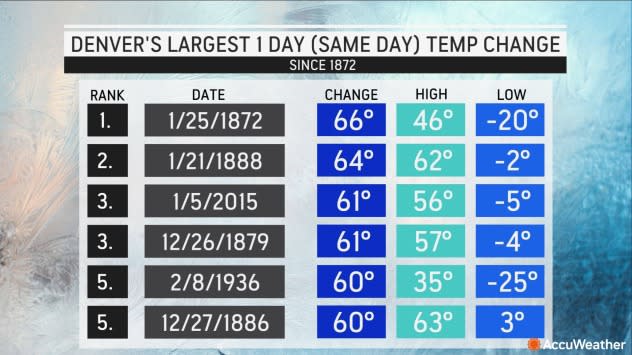Denver endures record-breaking temperature drop
A blast of Arctic air quickly dropped temperatures across the Rockies Wednesday, as part of a widespread cold outbreak that will leave most of the country in a deep freeze prior to the Christmas holiday.
Denver around 50 degrees Wednesday afternoon before the weather changed in a potentially historic way. Temperatures dropped rapidly between 3:53 p.m. and 4:35 p.m. local time, going from 42 degrees Fahrenheit to 5 degrees. According to preliminary data taken from Denver International Airport, the observed 37-degree temperature fall would be the largest one-hour drop in the station's history. The previous biggest one-hour drop was from 41 degrees to 6 degrees in the afternoon of January 27, 2007.
 |
The mercury plummeted below zero by 6 p.m., and will go all the way down to 24 degrees F below zero at the Denver Airport Thursday morning, for a total plunge of 73 degrees.
The recorded temperature of 24 F degrees below zero is just one degree shy of the December record at that location (25 degrees below zero in 1990), and only 5 degrees short of the all-time record of 29 degrees below zero.
Temperatures through Thursday night will remain well below zero. While Denver is used to frigid winter weather, a high temperature on Thursday of 5 degrees below zero would be the lowest high temperature since 1990.
AccuWeather RealFeel® Temperatures in Denver are expected to settle between 30 below zero and 40 below zero, and was at 39 below zero at 3 a.m. local time early on Thursday morning. Elsewhere, the RealFeel will be even harsher in cities such as Rapid City, South Dakota, and Scottsbluff, Nebraska, as both locations could record RealFeel temperatures as low as 60 below zero.
 |
Like Denver, Cheyenne, Wyoming also recorded its greatest one-hour temperature drop on record Wednesday, going from 43 degrees to 3 degrees in just 30 minutes.
The dangerous cold, such as the conditions expected in Denver, will bring potentially life-threatening concerns for residents. Frostbite on exposed skin can happen in as little as five minutes. If residents need to go outside for any reason, AccuWeather meteorologists recommend residents bundle up with multiple layers and wear a hat and gloves.
 |
Travel will also be impacted in the Denver area, as well as throughout Colorado, as crews clean up the several inches of snow that fell across the region into early Thursday morning. Holiday travelers on the roads should use caution and keep travel at a slow pace, whether they are staying in Colorado or driving to other states in the Plains also enduring the storm.
Denver is no stranger to rapid temperature changes. The National Weather Service in Boulder, Colorado, notes that the largest same-calendar-day temperature drop in the Mile High City's history took place on Jan. 25, 1872, when a high of 46 plummeted to a low of 20 below zero, a 66-degree fall that hasn't been tested in decades.
Wednesday's temperature drop just missed the top 5, by dropping 59 degrees before midnight Wednesday night.
 |
Denver's Largest 1-Day (Same-Calendar-Day) Temperature Changes since 1872 |
In more recent memory, the largest drop from high to low in Denver was on Oct. 9, 2019, when a warm afternoon temperature of 83 dipped to a low of 28 several hours later, a temperature change of 55 degrees in one calendar day.
A September 2020 drop from 92 degrees at 3 p.m. on a Monday to 36 degrees at 7 a.m. on a Tuesday, a plummet of 56 degrees, did not count on the list due to the swing beginning on one calendar day and ending on the next, according to the NWS.
Want next-level safety, ad-free? Unlock advanced, hyperlocal severe weather alerts when you subscribe to Premium+ on the AccuWeather app. AccuWeather Alerts™ are prompted by our expert meteorologists who monitor and analyze dangerous weather risks 24/7 to keep you and your family safer.






